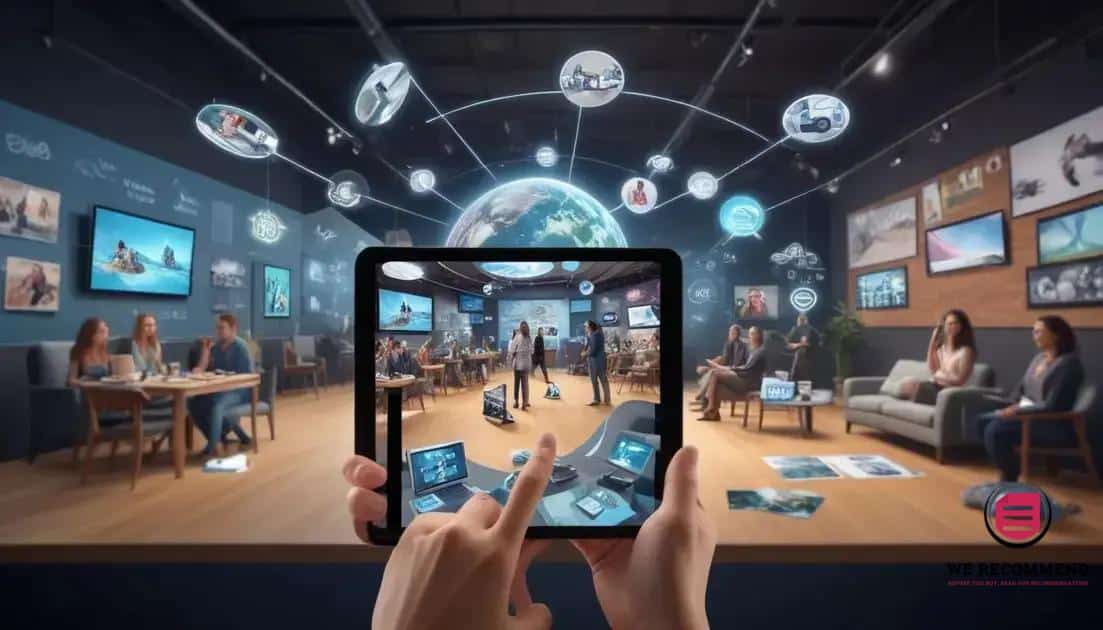Visual storytelling trends shaping the future of content

Anúncios
Visual storytelling trends include the use of augmented reality, interactive videos, and personalized content to enhance audience engagement and create immersive experiences that connect more deeply with viewers.
Visual storytelling trends are redefining how we connect with audiences. Have you ever noticed how a captivating image or video can tell a story better than words? Let’s dive into this evolving landscape and see what makes it so powerful.
Anúncios
Understanding visual storytelling
Understanding visual storytelling is essential for effectively communicating ideas and emotions. It combines images, videos, and graphics to create engaging narratives that resonate with audiences. A well-crafted visual story can captivate viewers, making them feel connected to the content.
Anúncios
To enhance your visual storytelling skills, consider the following key elements:
- Clarity: Your visuals should convey a clear message without overwhelming the audience.
- Emotion: Use colors and imagery that evoke feelings appropriate for your story.
- Consistency: Maintain a cohesive visual style to strengthen your brand identity.
For more insights, you can visit Nielsen Norman Group.
The rise of interactive content
The rise of interactive content is transforming how audiences engage with brands and stories. Unlike traditional static content, interactive elements invite users to participate actively, making the experience more memorable.
Popular types of interactive content include:
- Quizzes: Fun and informative, quizzes allow users to learn while experiencing a sense of achievement.
- Polls and Surveys: These tools gather insights while engaging users, making them feel their opinions matter.
- Interactive Infographics: Visual data representation that allows users to click and explore specific sections.
According to a report by Content Marketing Institute, interactive content can generate up to 2.5 times more engagement than passive content.
Creating immersive experiences
Creating immersive experiences is vital in engaging audiences and leaving a lasting impression. These experiences go beyond traditional content by involving users in a deeper, more interactive manner.
To craft effective immersive experiences, consider incorporating:
- Virtual Reality (VR): This technology allows users to explore environments as if they were actually there, enhancing the sense of presence.
- Augmented Reality (AR): AR overlays digital content onto the real world, providing users with additional information and context.
- Storytelling Techniques: Use narrative elements to guide users through the experience, making it more engaging and relatable.
According to Forbes, brands that utilize immersive experiences see higher engagement rates and customer loyalty.
Incorporating user-generated content

Incorporating user-generated content (UGC) is a powerful strategy for brands looking to enhance engagement and authenticity. UGC creates a sense of community and trust, as it comes directly from consumers who share their experiences and opinions.
Some effective ways to integrate user-generated content include:
- Social Media Campaigns: Encourage users to share photos or testimonials related to your brand using a specific hashtag.
- Contests and Giveaways: Create opportunities for users to submit their content for a chance to win prizes, increasing participation.
- Product Reviews: Highlight customer reviews and feedback on your website to build credibility and influence potential buyers.
According to HubSpot, user-generated content can increase brand loyalty and engagement significantly.
The role of video in storytelling
The role of video in storytelling is becoming increasingly important as audiences seek dynamic and engaging content. Videos can convey emotions, demonstrate products, and tell complex stories in ways that text and images alone cannot.
Key benefits of using video in storytelling include:
- Enhanced Engagement: Videos capture attention quickly, making it easier to hold viewers’ interest.
- Emotional Connection: The combination of visuals, sound, and narrative helps create a deeper emotional response.
- Versatility: Videos can be used across various platforms, from social media to websites, increasing their reach.
According to Wyzowl, 86% of businesses now use video as a marketing tool, emphasizing its importance in modern storytelling.
Best practices for visual content creation
Best practices for visual content creation can significantly enhance the effectiveness of your communication. Whether you’re creating images, videos, or graphics, following these guidelines can lead to better engagement and clearer messaging.
Here are some essential practices to consider:
- Consistency: Maintain a consistent style with colors, fonts, and layouts to establish a cohesive brand identity.
- Quality: Ensure high-quality visuals that are clear and professionally presented to build trust and credibility.
- Relevance: Align your visuals with the content and audience expectations, making sure they add value to the message.
For more insights on effective visual content strategies, you can visit Canva.
Leveraging social media for storytelling
Leveraging social media for storytelling is a strategic approach that allows brands to connect more personally with their audiences. Social media platforms provide the perfect environment for sharing narratives that resonate and engage users.
Consider the following strategies to effectively use social media for storytelling:
- Visual Content: Use images and videos to illustrate your story. Visuals enhance engagement and capture attention more effectively than text alone.
- Authenticity: Share real stories from customers or behind-the-scenes content to build trust and relatability.
- Interactive Elements: Encourage engagement through polls, Q&A sessions, or live videos. This helps audiences feel involved in the narrative.
According to Sprout Social, stories that are authentic and relatable generate much higher engagement rates on social media.
Future trends in visual storytelling

Future trends in visual storytelling indicate a shift towards more immersive, engaging methods of communication. As technology evolves, so do the strategies used to connect with audiences.
Some key trends to watch for include:
- Augmented Reality (AR): AR will continue to blend digital content with the real world, allowing for interactive experiences that enhance storytelling.
- 360-Degree Videos: This format offers viewers an opportunity to explore different perspectives and immerse themselves in the narrative.
- Personalization: Tailoring visual content to individual preferences and behaviors will become increasingly important in capturing audience interest.
According to Wired, brands that adopt these trends early will have a competitive advantage in engaging their viewers.
In summary, embracing visual storytelling is essential for modern communication
Visual storytelling enhances engagement and leaves a lasting impact on your audience. Whether through videos, interactive content, or social media, these methods help connect with viewers on a deeper level.
By staying updated on trends and best practices, you can create meaningful narratives that resonate. As technology evolves, so should your approach to storytelling.
Don’t underestimate the power of visual content; it can transform how your brand communicates and engages with its audience.
FAQ – Frequently Asked Questions about Visual Storytelling
What are the key elements of effective visual storytelling?
The key elements include clarity, emotion, and consistency. These factors help create engaging narratives that resonate with your audience.
How can social media enhance visual storytelling?
Social media platforms allow for sharing engaging content, receiving real-time feedback, and building community, all of which enhance the storytelling experience.
Why is augmented reality important for visual storytelling?
Augmented reality creates immersive experiences that captivate audiences, making the storytelling more interactive and memorable.
What future trends should I consider in visual storytelling?
Be aware of trends like personalized content, 360-degree video, and interactive formats that will shape how stories are told and experienced.






